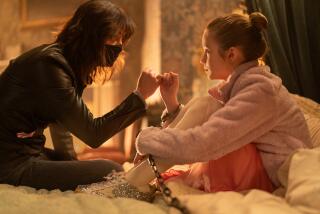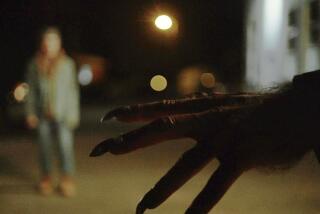Q&A: ‘Halloween’ director David Gordon Green on fighting against final girls, Michael Myers and the male gaze
David Gordon Green has had one of the most unpredictable careers in movie-making. Having burst on the scene with artful, emotional and enigmatic movies like “George Washington” and “All the Real Girls,” he transitioned to outrageously broad comedies like “Pineapple Express” and TV’s “Eastbound and Down.” And went on to prestige dramas (“Stronger”) and low budget oddities (“Prince Avalanche”).
His latest twist? Directing the most recent iteration of the venerable horror franchise “Halloween.” Co-written by Green, Danny McBride and Jeff Fradley, the new film is a direct follow-up to John Carpenter’s 1978 original, bypassing all the sequels and complicated mythos that followed.
In this “Halloween,” Laurie Strode (Jamie Lee Curtis, returning to the role that made her a star) has lived her life traumatized by the attack of Michael Myers, scarred by paranoia, fear and anger. When Michael escapes from custody and comes after her, Laurie and her daughter (Judy Greer) and granddaughter (Andi Matichak) face their deepest fears and biggest adversary.
Just ahead of the movie’s impressive $76-million opening weekend, which instantly made “Halloween” the director’s second highest grossing movie ever, the filmmaker jumped on the phone for a frank, spoiler-filled conversation about both the minute practicalities and big-picture concepts involved in taking on a story that has become ingrained in the pop culture consciousness.
RELATED: ‘Halloween’ expected to sink ‘Hunter Killer’ at the box office this weekend »
At the midnight premiere during the Toronto International Film Festival, the crowd was going so nuts over Judy Greer’s “gotcha” line during the finale that they couldn’t hear Jamie Lee Curtis’ “Happy Halloween, Michael” line. It must have been gratifying to see an audience responding like that.
I’ll tell you an interesting thing ... it’s about editing and test screenings. Test screenings are beautiful because you can know how to move things around for those types of audience responses. But I’d never tested that line because I thought it was like, “Oh, is that too much?” And then the last change we made in our picture cutting was to add that line back in. Then the result is that you don’t hear it because we put it in the wrong place. It’s got its own charm as obviously people will watch the movie in different environments without necessarily a ruckus. It’s in there.
Structuring this story around the three generations of Strode women, then building to the showdown with Michael, were you consciously trying to work against the horror trope of the final girl, instead creating something of a final group?
Yes, [we were] going against the final girl. You know, every sub-genre of horror has its waves. Recently, we’ve gone through some vampires, we’ve gone through some zombies ... we’re going to show back up with a slasher movie, and it’s been awhile. So [we thought] let’s invite certain tropes to our conversation and then spin as many of them as we can so that there is a modern context for this experience. And just the typical scream queen final girl — it feels like a different era.
I’ll also say, reading early interviews and reviews of Carpenter’s film, there were a lot of people applauding and calling it an intelligent and interesting female lead character, a substantial character from the original “Halloween.” So we’re thinking, “That’s great. That’s what makes this different.” And so let’s double down, triple down on that.
Did you debate how much character to give to Michael?
Our rule in the writing process was to give him nothing… In production, we added one thing that may come back to haunt me, but I stand by it at the moment. We gave him an ethical decision in which he doesn’t kill the baby. That was something that came up while we were shooting.
We were looking for an interesting 15-second gap in a long sequence. And there were 15 seconds, no tension, no new information. And the goal was, ‘How do we put something that’s 15 seconds’ worth of intrigue in the sequence?’ And the production designer and the DP came up with the idea of putting a baby crib in the living room and then a baby. It was one of the things that was just exciting, and it fixed the problem; it filled the gap.
And now we’re looking at a character who I proclaim is the essence of evil and has no motivation, no emotion, no real stimulation other than being a predator. And yet we’ve given him this one consideration in which he does the right thing. So I’m not exactly sure how to stand by that and justify that, although I think it’s fascinating to think of someone that is nothing but a cold-blooded, faceless, motivation-less killer. He made one decision that we are happy that he made.
So at the end of the movie, the gas explosion happens, the house is on fire and yet we still don’t exactly see Michael dead. Aside from the obvious answer of a sequel, why did you want to leave it open like that?
I was drawn to the ambiguity of the ending of Carpenter’s 1978 film and wanting to mirror that. And we toyed with ideas like those. We established an environment on fire that seems impenetrable, and a moment later you see a wide shot of the environment that we’ve established with him engulfed in flames. And there’s a very specific length of shot that doesn’t linger long enough for you to be confident whether he’s there somewhere or he isn’t.
That’s the science of my ending — before your eyes have combed every corner of that room for suspicious shapes, you’re no longer privy to that point of view, until you take it home and freeze frame. And that was our conversation, how do we say, ‘Is he in there? I don’t think I saw them, but maybe was that him,’ or ‘My eyes went to a specific place, I know that’s him, he’s in there and he’s moving.’ It’s me trying to have that engaging ending rather than any sort of confident finale.
The original had those very famous POV shots through Michael’s mask that made the idea of the male gaze very explicit in the original film. As writers and then as a director, how did you deal with trying to center three women’s stories, to have it be a female-led story?
Well, I could never rid myself of the male gaze, unfortunately. So as writers, Danny and Jeff Fradley and myself bring our architecture of what we think would be fun as viewers. And dispelling the [trope of] final girl, the scream queen, and empowering the female characters, we can only do that to such a degree because of our genetics. So at a point, you cast the … out of a movie and you put powerhouses in these roles, and you ask questions of them, and you invite them into the creative conversations, and you hand the roles to them. And you do engage as a reactive director, as much as an active director, so that you can make it honest and emotional and take it to a place that the architecture wasn’t going to do all along.
Some people would like to see female-fronted horror movies, this one in particular, actually directed by women. How do you respond to that?
That’s great. I think there’s a symphony of voices that are possible within our creative industry. And it’s a collaborative industry, so just as much as I choose to invite a diversity of voices into every creative project that I do, I don’t stand by any sort of auteur theory, and I’m not a dictatorial director. I’m only as strong as my crew and my cast, so if I’ve surrounded myself with points-of-view, perspectives, creative opportunity, then that project’s going to benefit beyond that I’m only a very specific, single person. As much of a community I can trust and embolden with the opportunity of storytelling, it’s going to make my story that much stronger.
I think there are filmmakers and stories that should be told, so scientifically, specifically and microscopically, that I’m in awe of what they do. The precision of certain directors that are left to their own autonomy can blow my mind with their specific choices. But that’s just not me. And that’s not typically the movies that I’m drawn to. I’m drawn to the quilts, the collage of ideas, the personalities and all of their diversity, joining hands for our specific creative vision. Now you’ve got something.
SIGN UP for the free Indie Focus movies newsletter »
Follow on Twitter: @IndieFocus
More to Read
Only good movies
Get the Indie Focus newsletter, Mark Olsen's weekly guide to the world of cinema.
You may occasionally receive promotional content from the Los Angeles Times.







